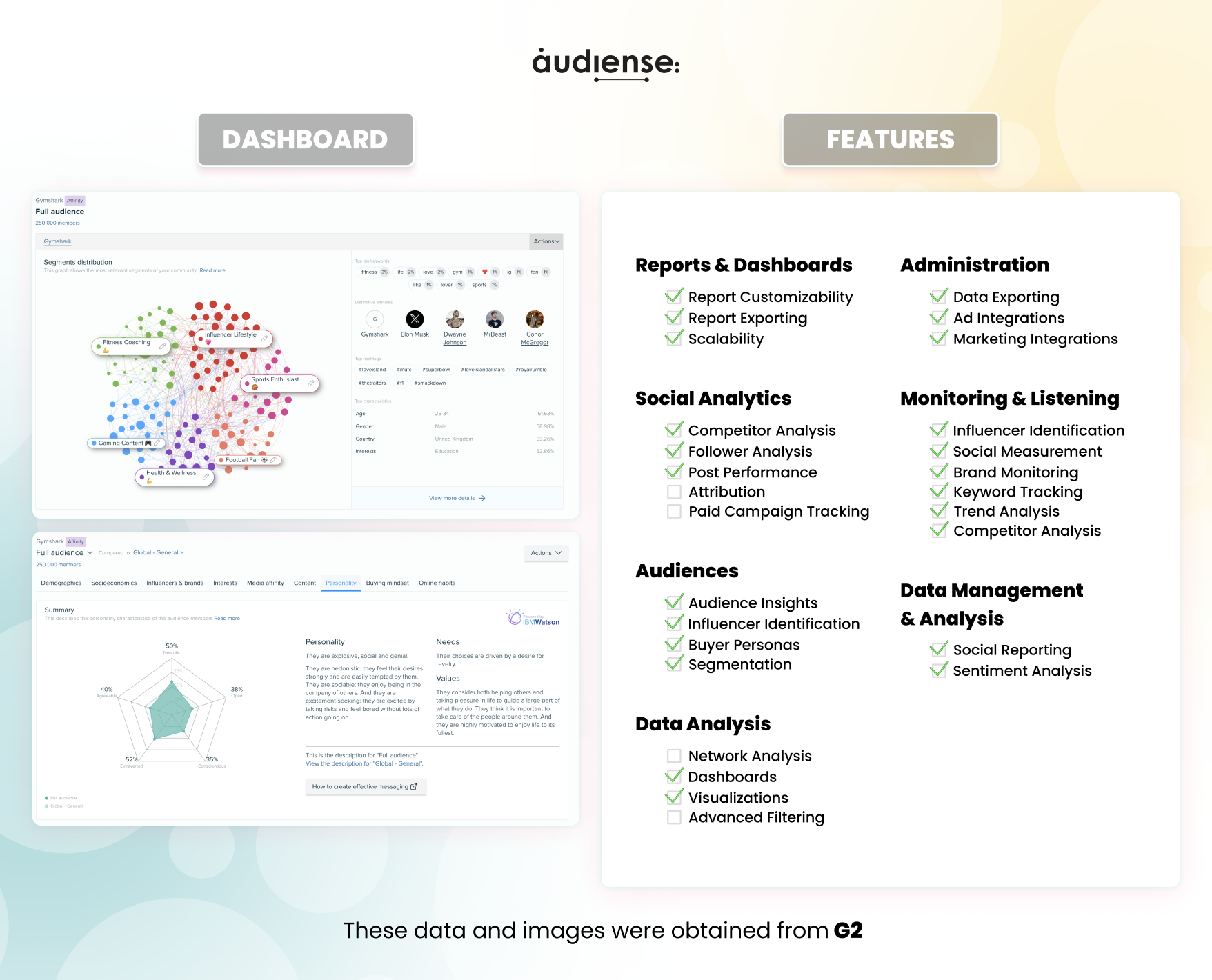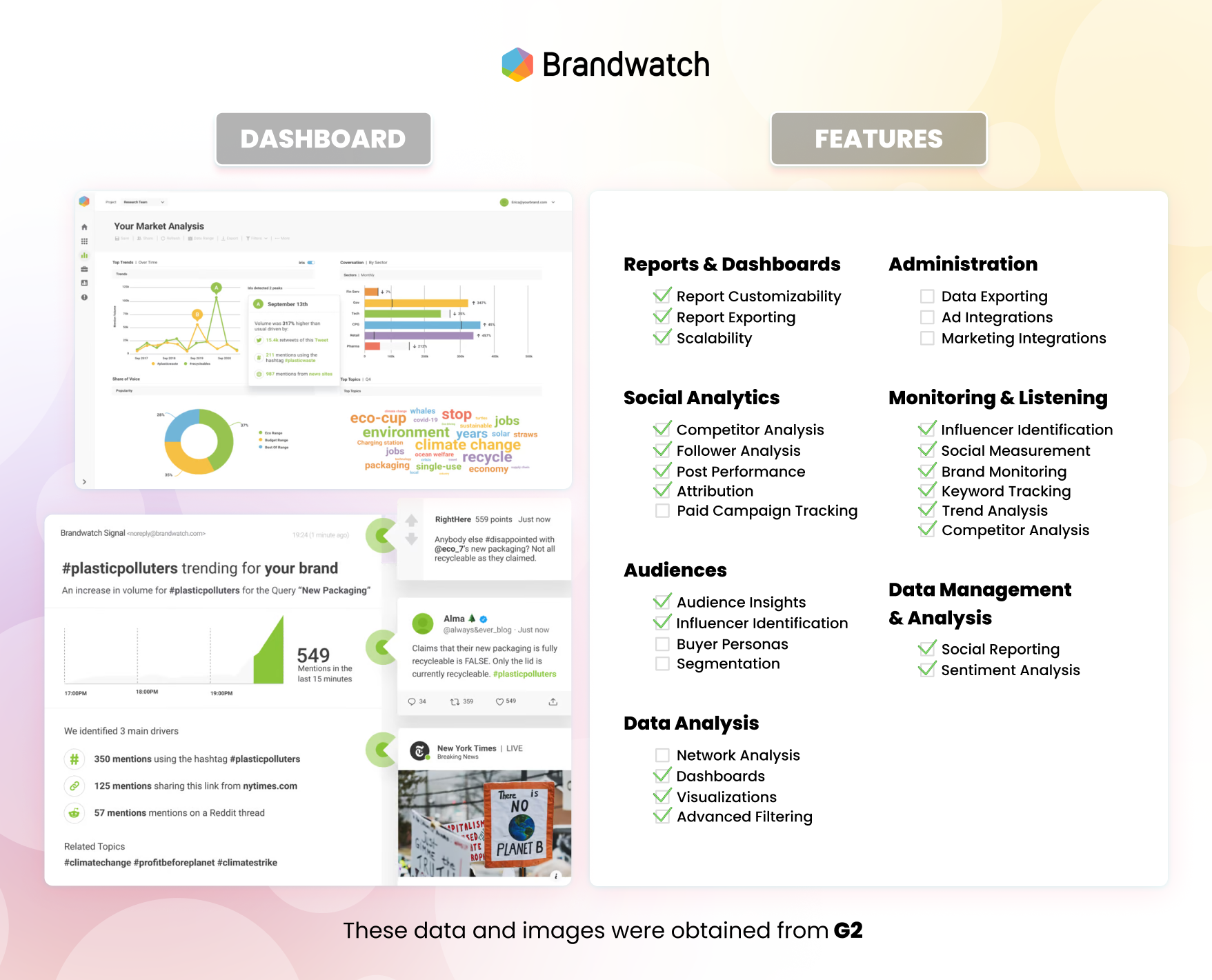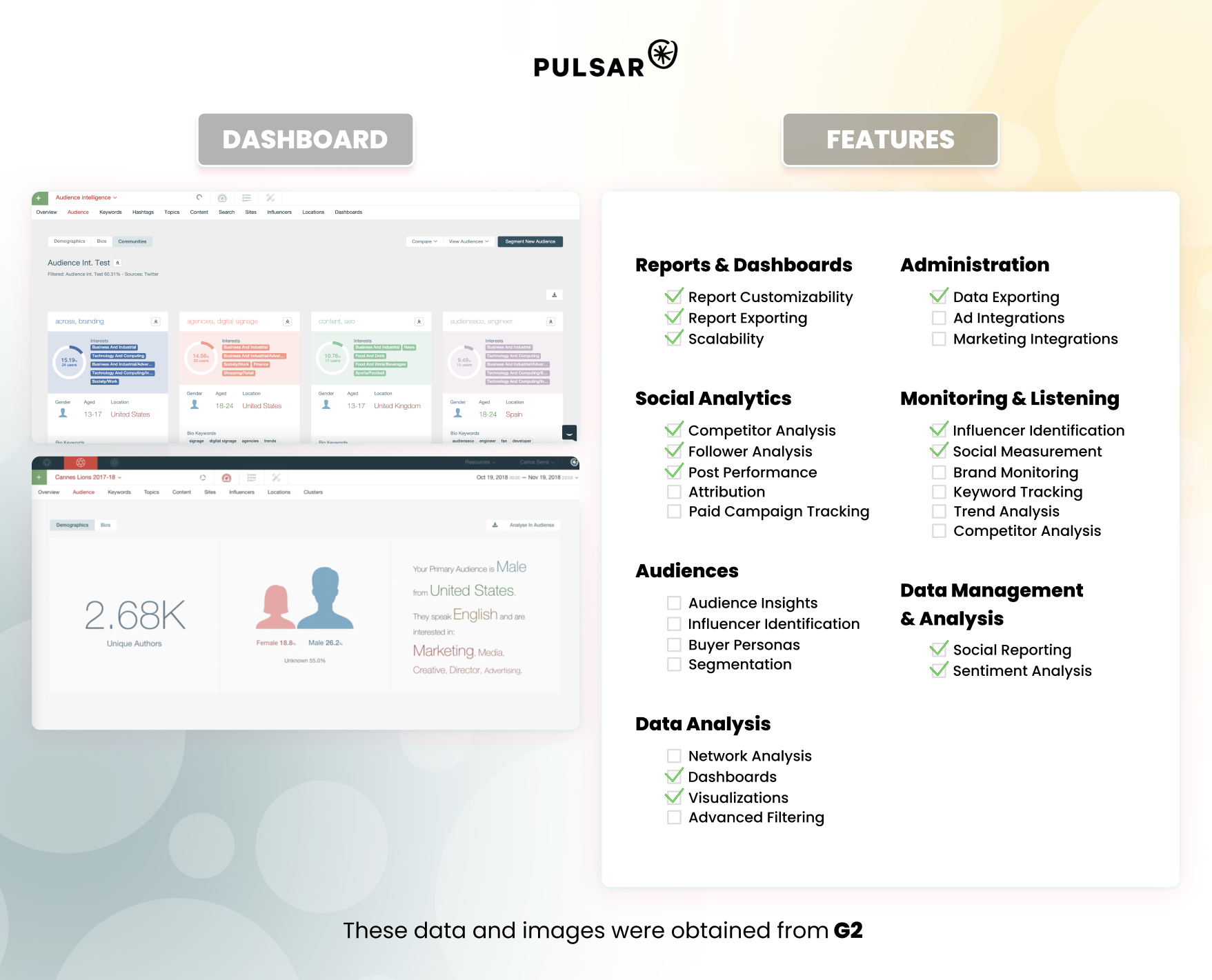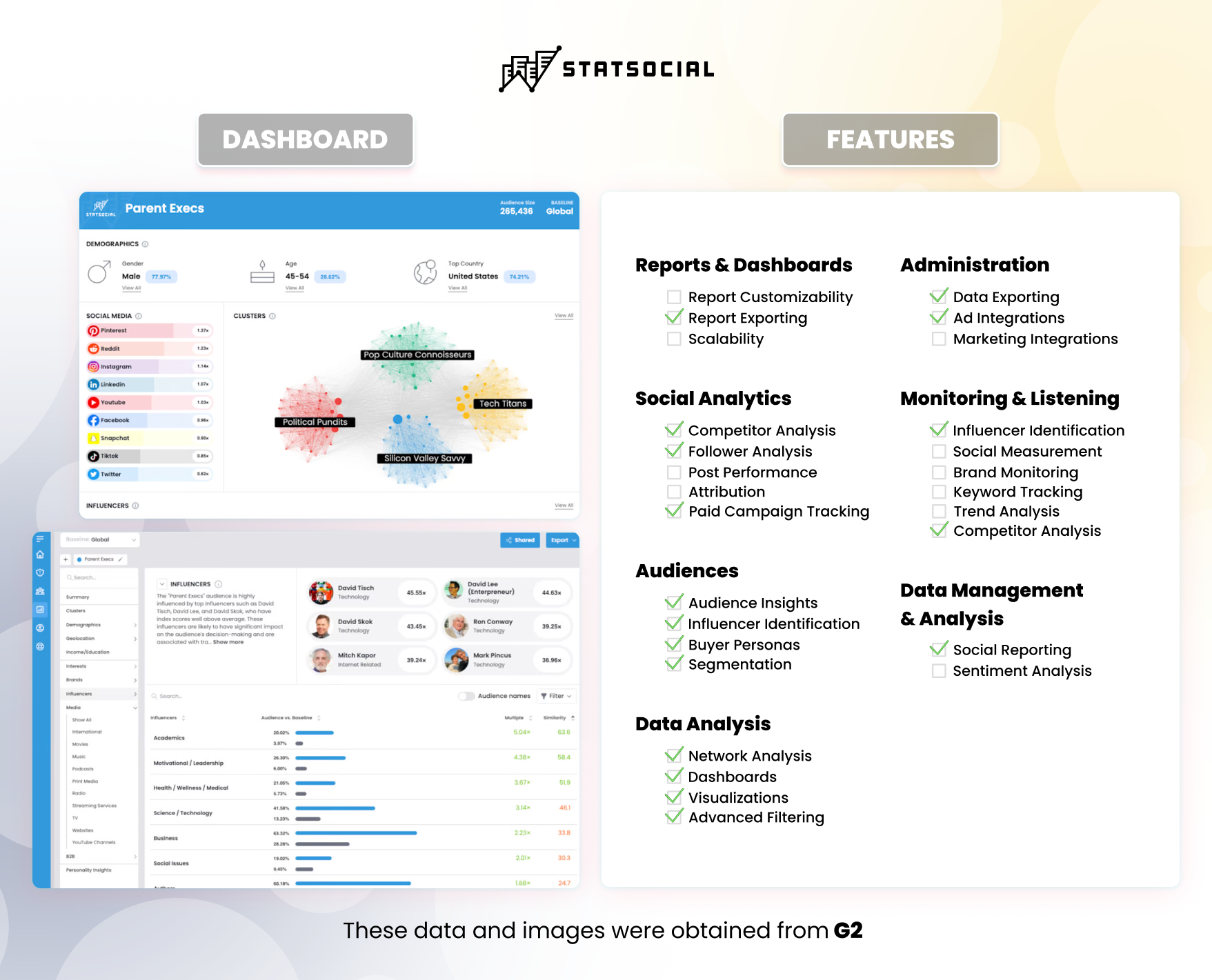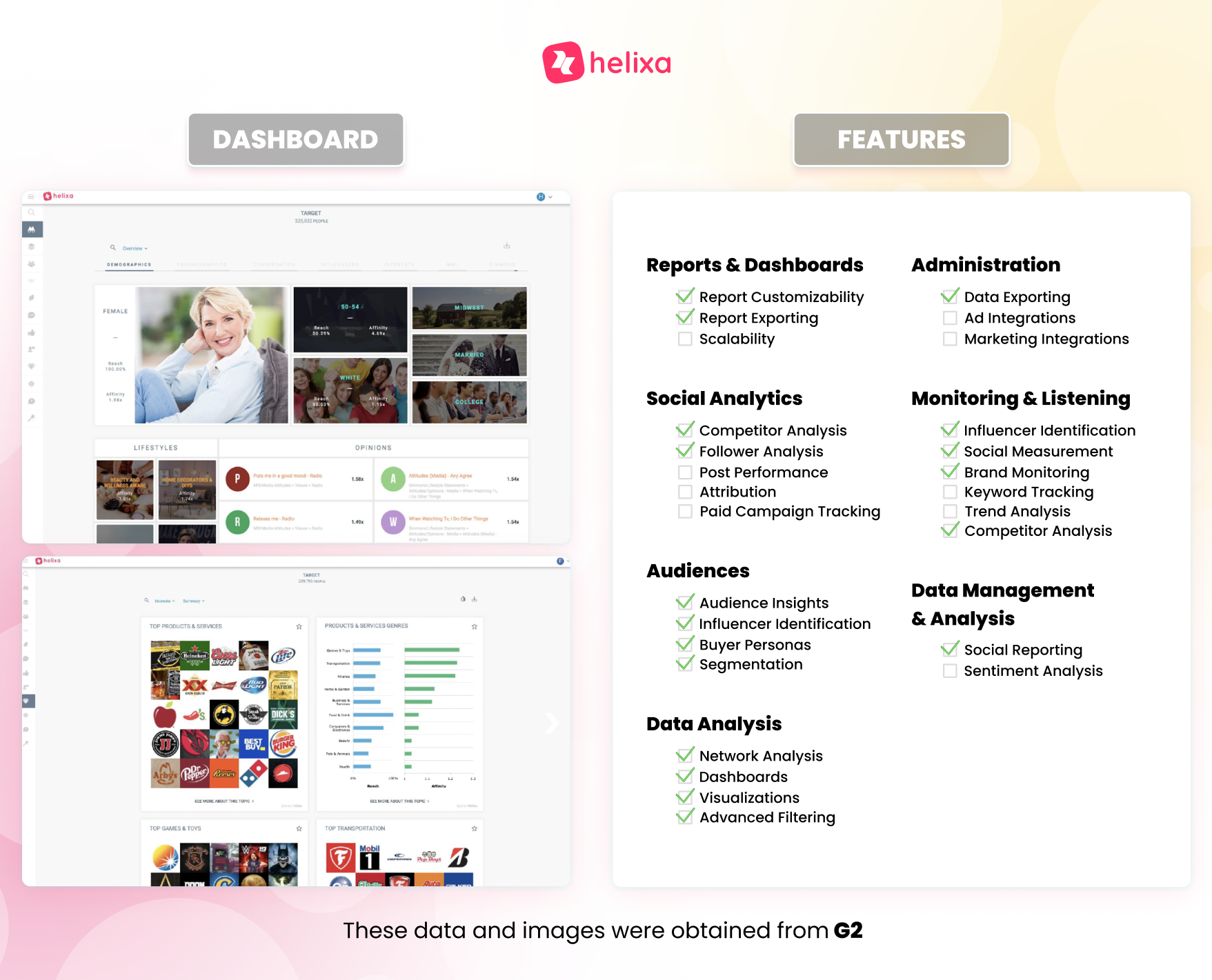Le guide ultime pour choisir la meilleure plateforme d'intelligence d'audience pour votre agence
Si votre objectif est de créer des campagnes marketing qui s'adressent à votre public cible, garantissant des taux d'engagement et de conversion élevés tout en impressionnant vos clients, la maîtrise de l'intelligence d'audience est essentielle. Mais à quoi ressemble une intelligence d'audience efficace, comment pouvez-vous l'exploiter et quelles sont les caractéristiques que vous devez rechercher lorsque vous choisissez une plateforme d'intelligence d'audience pour votre agence ?
Ce guide complet répond à toutes ces questions et à bien d'autres encore.
Qu'il s'agisse de rehausser la marque de votre client, d'affiner stratégies de marketingou tout simplement d'acquérir un avantage concurrentiel dans le paysage dynamique des agences, ce guide est votre feuille de route essentielle. Il est conçu pour aider votre agence à choisir la meilleure plateforme d'audience intelligence afin que vous puissiez prendre des décisions basées sur des données, créer des stratégies efficaces et devenir un héros du marketing aux yeux de vos clients.
Allons-y.
Qu'est-ce que l'intelligence de l'audience ?
L'intelligence de l'audience est la pratique stratégique qui consiste à comprendre en profondeur votre public cible en regroupant et en analysant les données suivantes l'analyse des ensembles de données complets. Ces données comprennent un large éventail d'empreintes numériques laissées par le public, notamment les interactions sur les plateformes de médias sociaux, les comportements sur les sites web et les engagements enregistrés dans les systèmes de gestion de la relation client (CRM).
Imaginez que vous puissiez décoder le langage numérique de votre public cibleet de comprendre leurs désirs et leurs freins comme s'ils étaient ouvertement partagés avec vous. Ce niveau de connaissance, qui va bien au-delà des simples données démographiques, vous permet d'adapter vos stratégies de marketing et vos campagnes numériques avec une précision sans précédent, ce qui se traduit par une augmentation de l'engagement, des taux de conversion et de la fidélité des clients.

Plongez dans un exemple de rapport rapport d'intelligence d'audience.
Comment les meilleures agences exploitent l'intelligence de l'audience
Comment les agences acquièrent-elles des informations sur l'audience - suivent-elles l'audience de leurs clients et l'étudient-elles ? Non, elles utilisent des plateformes d'intelligence d'audience.
Ces plateformes font tout le travail à leur place ; elles capturent les données d'audience, les analysent et présentent ensuite les résultats sous forme de tableaux de bord et de visuels colorés, ce qui permet à tout un chacun de comprendre qui est son audience, sans jamais l'avoir rencontrée.
En 2024, la plupart des agences de marketing utilisent un système de outil d'intelligence d'audience de l'audience. Elles savent que si elles ne le faisaient pas, elles créeraient des campagnes basées sur leurs propres hypothèses d'audience plutôt que sur des données, ce qui conduirait à un ciblage très inefficace, à des publicités peu performantes, à des taux de conversion faibles et à un gaspillage des ressources du client.
Le monde des agences est bien trop compétitif pour cela, et les marques s'attendent à ce que leurs agences travaillent avec des outils d'intelligence d'audience. Si la plupart des agences en utilisent un, qu'est-ce qui fait qu'une agence est plus compétitive qu'une autre ? Tout dépend de l 'outil de veille d'audience qu'elles utilisent.
En choisissant le bon outil d'intelligence d'audience, les agences peuvent naviguer en toute confiance dans les complexités du marketing moderne, en s'assurant non seulement de répondre aux attentes de leurs clients, mais aussi de les dépasser dans une ère axée sur les données.
Ceci étant dit, nous allons nous pencher sur la question et évaluer comment choisir la meilleure plateforme d'intelligence d'audience pour votre agence.
L'intelligence de l'audience à la rescousse
L'époque du marketing à la Don Draper est révolue. Désormais, chaque décision prise par une agence doit être étayée par des donnéeset pas seulement sur une idée créative géniale que l'équipe de l'agence a eue.
Mais les "données" ne sont pas sans poser de problèmes.
Les agences n'ont pas toujours accès aux données dont elles ont besoin sur les clients de leurs clients, en raison du GDPR et de la réglementation en matière de protection de la vie privée. Si elles ont accès aux données de première partie de leurs clients, elles ont alors besoin d'un Data Scientist pour les interpréter et personne n'a le temps pour cela, n'est-ce pas ?
Quelle est la solution au problème des données ? Les plateformes d'intelligence d'audience et les plates-formes d'intelligence d'audience.
Les plateformes d'intelligence d'audience rassemblent les données sur l'audience de votre client pour que vous n'ayez pas à le faire, éliminant ainsi toute paperasserie ou problème de conformité au GDPR. Ensuite, grâce à l'utilisation de l'IA et de l'apprentissage automatique, l'outil d'intelligence d'audience fait automatiquement apparaître les informations les plus importantes. En général, ce processus ne prend pas plus d'une demi-heure et les informations sont toujours disponibles en temps réel.
Les informations fournies par les plateformes d'intelligence d'audience sont présentées de manière à pouvoir être comprises par n'importe qui, quelle que soit sa formation professionnelle. Cela signifie que les informations peuvent être partagées par de nombreuses parties prenantes et équipes différentes, supprimant ainsi les silos de données et permettant à tous les membres de l'agence de prendre des décisions fondées sur des données.
Les plateformes d'intelligence d'audience résolvent bien plus que le problème des "données" auquel sont confrontées les agences. En fait, elles sont utilisées pour d'innombrables cas d'utilisation et résolvent d'innombrables défis auxquels les agences sont confrontées.
Ils peuvent supprimer un grand nombre d'outils supplémentaires de la pile technologique de votre agence, car ils agissent comme un guichet unique pour de nombreuses fonctions de marketing.
Voyons maintenant ce dont les plateformes d'intelligence d'audience sont capables.
Les meilleures plateformes d'intelligence d'audience aident les agences à.. :
Découverte du public
- Segmenter l'audience de leurs clients de manière automatique et impartiale, sur la base de leurs intérêts et comportements communs. Cela permet aux agences de comprendre l'audience dans son ensemble, mais aussi la répartition de l'audience et les segments qui la composent. La connaissance de ces segments permet d'élaborer des stratégies marketing sur mesure pour chacun d'entre eux, afin de ne pas adopter une approche marketing "unique".
- Élaborer des profils clients détaillés sur lesquels l'ensemble de l'agence pourra s'appuyer et se référer.
- Identifier les meilleurs segments à cibler avec des expériences marketing personnalisées. Pour ce faire, ils montrent quel segment s'intéresse le plus à la marque d'un client, de sorte que ce segment puisse être ciblé spécifiquement et attirer davantage de personnes comme lui, ce qui permet au final d'accroître l'audience du client.
- Accélérer l'étude du public lorsque le client présente à l'agence un cahier des charges créatif, en supprimant la nécessité d'une étude de marché longue et coûteuse (par exemple, des groupes de discussion) et en permettant à l'agence d'être à la hauteur du cahier des charges.
- Enrichir les données de première main du client en les complétant par des informations colorées et approfondies (l'agence peut télécharger les données de première main du client dans la plateforme d'intelligence d'audience, afin de les segmenter et de les compléter par des informations plus approfondies).

Optimisation des campagnes
- Informer l'achat de médias, en mettant en évidence les principaux médias pour l'audience du client, afin qu'il sache quels canaux utiliser pour l'atteindre au mieux et obtenir un retour sur investissement élevé.
- Sélectionner et vérifier les influenceurs à engager pour différentes campagnes. Les outils de veille de l'audience font apparaître les principaux influenceurs auxquels l'audience du client s'intéresse le plus. Les agences peuvent donc sélectionner les influenceurs en fonction de leur résonance avec l'audience du client, et non en fonction de leur nombre d'adeptes.
- Faire émerger des partenariats/collaborations de marques rentables en découvrant les marques qui intéressent le plus le public du client (par exemple, e.l.f. Cosmetics et Chipotle ; ce partenariat a été très fructueux, et il s'agissait de deux marques qui ne semblaient pas liées, mais dont le public se recoupait fortement).
- Créer un contenu qui trouvera un écho auprès du public, en mettant en évidence les informations nécessaires pour alimenter le message, les visuels et l'animation en ligne qui attirent le public de votre client.
- Suivre les performances des campagnes en comprenant quels publics chaque campagne de marketing a attiré ; la campagne est-elle bien ciblée et attire-t-elle les publics visés ou l'agence doit-elle réorienter sa stratégie ? Plus l'agence est rapide à le déterminer, moins elle gaspille d'argent en ciblant le mauvais public !
- Améliorez l'efficacité de vos campagnes en comprenant quel contenu marketing, quel visuel, quel texte sera le plus efficace pour chaque segment de public.
Expansion du marché
- Suivre et évaluer les changements de l'audience du client afin que la marque puisse évoluer en même temps que les préférences changeantes de l'audience.
- Mettre en évidence les tendances de l'audience qui présentent de nouvelles opportunités de marché pour le client.
- Réalisez une analyse concurrentielle rapide mais approfondie en faisant apparaître l'audience du concurrent et en comprenant quelles sont les stratégies de marketing qui fonctionnent pour lui et que votre client pourrait tenter d'appliquer. Cela permet également aux agences de comprendre quelles sont les audiences capturées par un concurrent que leur client n'a pas encore envisagées/ciblées, et quelles sont les audiences que leur client domine et pourquoi.
- Évaluer la part de marché du client, en montrant quels sont les publics dominés par le client dans l'ensemble du secteur et quels sont ceux qu'il doit cibler pour élargir son champ d'action.
- Informer une stratégie de localisation marketing en faisant remonter des informations sur les différents publics à travers le monde, permettant ainsi à leurs clients de cibler chaque lieu de manière appropriée et efficace, et d'étendre leur présence à l'échelle mondiale.
Gestion de crise
- Résoudre rapidement une crise de relations publiques en identifiant les publics les plus touchés/incommodés par la "mauvaise presse", afin d'élaborer des stratégies pour reconquérir ces publics.
Croissance de l'agence
- Démontrer qu'il s'agit d'une agence qui s'appuie sur des données. Les outils d'intelligence d'audience sont la meilleure ressource qu'une agence puisse utiliser pour rester compétitive et créer des stratégies de marketing primées.
- Remporter des pitchs clients en permettant une recherche rapide de l'audience en préparation du pitch, et en faisant émerger des informations impressionnantes sur l'audience du client - en donnant l'impression que l'agence connaît l'audience du client en profondeur, et en prouvant que les stratégies élaborées par l'agence sont étayées par des données.

Choisir la bonne plateforme d'intelligence d'audience pour votre agence
Vous avez appris ci-dessus qu'il existe de nombreux défis/fonctions marketing qu'une plateforme d'intelligence d'audience peut résoudre. Cependant, toutes les plateformes d'intelligence d'audience ne sont pas égales - certaines sont plus efficaces que d'autres pour relever ces défis.
Alors, comment choisir la bonne pour votre agence ? En fin de compte, il s'agit d'essayer une plateforme et de tester ses capacités en fonction de vos besoins et de vos objectifs.
Cela ne veut pas dire que vous devez TOUT essayer, cela prendrait une éternité. La première étape consiste donc à réduire le nombre de plateformes que vous allez essayer et à rechercher des plateformes d'intelligence d'audience dotées de ces fonctionnalités de base :
- Des moyens infinis de filtrer, de construire et de découvrir des audiences
- Segmentation de l'audience
- Capacités d'analyse des intérêts et des comportements
- Des connaissances approfondies mais simplifiées, sur lesquelles vous pouvez agir
- Données démographiques et psychographiques de l'audience
- Mesures de l'engagement du contenu des médias sociaux
- Affinités avec les influenceurs, les partenaires et les médias
- Identification des tendances
- Analyse des concurrents
- Intégration d'outils ; intégration facile avec votre plateforme CRM, vos comptes de médias sociaux, etc.
- Une plateforme qui s'adapte en permanence à l'air du temps et aux nouveaux besoins des agences
- Graphiques d'intérêt ; visuels qui montrent le niveau d'intérêt d'un public pour quelque chose en fonction d'un score affiché.
- Aperçu de la personnalité ; une description résumée des sentiments de votre public, basée sur des données sociales/de première partie.
- Des visuels qui peuvent être partagés et compris universellement, et utilisés pour créer des argumentaires gagnants pour les clients.
- La capacité d'analyser des données de tiers (sociales) et des données de première main
- la possibilité d'exporter des listes d'audience à des fins de ciblage et la possibilité de cibler des audiences directement via la plateforme d'intelligence d'audience.
*Conseil : lors de votre premier contact avec l'équipe de vente d'une plateforme, vous pouvez même leur envoyer cette liste et leur dire que je cherche une plateforme qui a... (copiez et collez la liste ci-dessus), et s'ils reviennent et qu'il manque certaines fonctionnalités, vous savez que cela signifie que vous devez continuer à chercher.
Les plateformes d'intelligence d'audience donnent de vrais résultats
La preuve est dans le pudding, ou dans ce cas, la preuve est dans l'agence études de cas.
Non seulement les outils d'intelligence d'audience aident les agences à faire leur travail, mais ils permettent également d'obtenir des résultats concrets.
Voici quelques études de cas montrant comment les meilleures agences utilisent les plateformes d'intelligence d'audience pour réussir.
Fournir aux agences les informations nécessaires pour aider leurs clients à conquérir des clients fortunés

Relevance, une agence de marketing de luxe, a utilisé une plateforme d'intelligence d'audience pour cibler les personnes fortunées pour son client de la marque de luxe Yacht. Plus précisément, Relevance a utilisé cette plateforme pour segmenter segmenter cette audience de personnes fortunées et de cibler chaque segment avec un message hautement personnalisé, en s'appuyant sur les informations fournies par l'outil d'intelligence d'audience.
Les informations recueillies ont notamment permis de déterminer le type de contenu auquel ces segments étaient le plus sensibles, ce qui a guidé la stratégie de contenu de l'agence. Grâce à l'intelligence de l'audience, l'agence a pu élaborer des messages qui ont entraîné des taux d'engagement et de conversion élevés, aidant ainsi son client à gagner de nouveaux clients fortunés. Lire l'étude de cas complète ici.
Permettre aux agences d'aider leurs clients à accroître leur part de marché

L'agence Convosphere a utilisé une plateforme d'intelligence d'audience pour aider ses clients (une marque multinationale d'éducation) à se développer sur les marchés allemand, français et japonais. À l'aide de données conversationnelles et de médias sociaux, l'agence a pu comprendre les besoins et le potentiel de chaque marché. Grâce à cette recherche, l'outil d'intelligence d'audience a révélé qu'il y avait un grand besoin d'éducation STEAM et d'accès numérique à cette éducation. L'entreprise a utilisé ces informations pour créer une stratégie qui l'a aidée à pénétrer et à conquérir ces nouveaux marchés. Lire l'étude de cas complète ici.
Permettre aux agences de dénicher de nouvelles opportunités (événements) pour leurs clients

Maven Road a travaillé avec IBM pour identifier les principaux événements auxquels ses clients participaient. En utilisant l'intelligence de l'audience, ils ont analysé les conversations des clients d'IBM sur les médias sociaux et ont mis en évidence les principaux événements pour lesquels cette audience avait des affinités. Grâce à ces informations, ils ont pu créer une stratégie autour de la participation d'IBM à ces événements, ce qui a permis d'accroître l'exposition de la marque.Lire l'étude de cas complète ici.
Comparaison outil par outil
Maintenant que vous avez eu la preuve de la puissance des plateformes d'intelligence d'audience et que vous savez ce qu'il faut rechercher lorsque vous êtes à la recherche d'une plateforme, nous avons pensé qu'il serait encore plus utile de réduire le nombre de plateformes pour vous. Nous vous présentons ci-dessous les cinq meilleures plateformes d'audience pour les agences, afin que vous puissiez trouver celle qui vous convient le mieux.
Audiense ⭐ 4.5/5 étoiles
Audiense est une plateforme d'intelligence d'audience connue pour aider les agences à comprendre ce qui inspire, émeut et influence n'importe quelle audience.
Audiense aide les agences à segmenter ces publics en fonction de leurs centres d'intérêt et à obtenir de riches informations culturelles qui sont utilisées pour élaborer des stratégies de marketing personnalisées.
Les agences utilisent Audiense pour comprendre les affinités des publics de niche et créer de meilleurs personas à partir desquels travailler. Les rapports d'Audiense couvrent tous les aspects, depuis les influenceurs avec lesquels leurs clients devraient travailler jusqu'au contenu à créer pour trouver un écho auprès de leur public.
Les utilisateurs aiment cette plateforme parce qu'elle les aide à comprendre quels segments de consommateurs valent la peine d'être ciblés, et qu'elle fait apparaître les informations nécessaires pour améliorer la connexion, les conversions et l'expérience client.
Voici un aperçu de la plateforme Audiense et de ses caractéristiques :
Brandwatch ⭐ 4.4/5 étoiles
Brandwatch permet aux agences de surveiller les marques de leurs clients, leurs concurrents et les tendances du secteur à travers plus de 100 millions de sources en ligne.
Plus précisément, il permet aux agences de surveiller et de déchiffrer les conversations en ligne que les gens ont à propos de n'importe quelle marque, dans le monde entier et dans plus de 30 langues différentes.
Brandwatch fait également office d'outil de gestion des médias sociaux, où vous pouvez créer, programmer et surveiller les posts sur tous les réseaux et canaux, à partir d'un seul endroit.
Les agences utilisent cette plateforme pour "analyse des sentiments"et les utilisateurs apprécient qu'elle leur permette de connaître l'audience de n'importe quel sujet, à travers de multiples sources de contenu.
Jetez un coup d'œil au tableau de bord de Brandwatch et aux fonctionnalités de cette plateforme :
Pulsar ⭐ 4.4/5 étoiles
Pulsar aide les agences à mesurer et à optimiser les performances des sites web et des canaux sociaux de leurs clients.
Les agences utilisent cette plateforme pour accéder aux audiences numériques et les analyser en un seul endroit. Elle les aide à faire le lien entre les conversations en ligne et les tendances de consommation.
Pulsar aide à suivi de la marque et la mesure des campagnes, et les informations obtenues sont généralement utilisées pour inspirer la créativité des campagnes de marketing.
Voici un aperçu du tableau de bord de la Pulsar et de ses caractéristiques :
Statsocial ⭐ 4.3/5 étoiles
StatSocial permet aux utilisateurs de comprendre ce qui rend une audience unique.
Les agences utilisent StatSocial pour mener des recherches approfondies sur les audiences de leurs clients ou de leurs concurrents.
Les informations fournies par cette plateforme aident les agences à choisir les meilleurs influenceurs et canaux médiatiques avec lesquels s'associer pour atteindre et toucher n'importe quel public.
StatSocial a également la capacité d'enrichir n'importe quel ensemble de données de première ou de tierce partie, afin d'éclairer davantage les affinités et les préférences de l'audience.
Jetez un coup d'œil à la plateforme StatSocial et à ses caractéristiques :
Helixa ⭐ 4/5 étoiles
Helixa est une plateforme d'intelligence d'audience qui utilise l'IA et l'apprentissage automatique pour connecter et analyser les données d'audience.
Cette plateforme aide les agences à créer des personas détaillés pour le public de leurs clients en faisant ressortir des éléments tels que les attributs de personnalité, les données démographiques et le comportement des consommateurs.
Les données obtenues par Helixa sont organisées en rapports synthétiques faciles à comprendre et à exploiter.
Des agences comme Helixa Les agences apprécient l'interface conviviale et le tableau de bord visuellement attrayant d'Helixa. Helixa permet de recueillir rapidement des informations sur n'importe quel public et est souvent utilisé pour le développement stratégique précoce de nouveaux produits, publicités et offres de marque.
Exploiter la puissance de l'intelligence de l'audience avec Audiense
Dans le monde concurrentiel des agences, où chaque décision doit être étayée par des données, les plateformes d'intelligence d'audience sont d'une valeur inestimable pour prospérer. En exploitant la puissance de l'intelligence d'audience, les agences peuvent complètement transcender leurs stratégies de marketing, construire des campagnes hautement ciblées et réussies, et prouver à leurs clients qu'elles sont des leaders dans cette ère axée sur les données.
Alors que vous vous apprêtez à trouver la meilleure plateforme pour votre agence, nous espérons que vous vous reporterez à ce guide. Choisir la bonne plateforme, c'est débloquer des opportunités, obtenir des résultats concrets pour vos clients et propulser votre agence vers la croissance et le succès.
Devenez un héros stratégique pour vos clients. Inscrivez-vous à Audiense et ouvrez la voie à l'innovation, à la créativité et à des campagnes marketing gagnantes.
FAQ
Q1 : Qu'est-ce qu'une plateforme d'intelligence d'audience ?
R1 : Une plateforme d'intelligence d'audience est un outil qui aide les responsables marketing à collecter, analyser et interpréter les données relatives à leur public cible. Ces plateformes offrent des informations sur les comportements, les préférences et les caractéristiques démographiques du public, ce qui permet aux spécialistes du marketing d'adapter leurs stratégies afin d'accroître l'engagement et l'efficacité.
Q2 : Pourquoi les agences ont-elles besoin d'une plateforme d'intelligence d'audience ?
A2 : Les agences ont besoin d'une plateforme d'intelligence d'audience pour prendre des décisions basées sur des données, améliorer le ciblage des campagnes, améliorer les résultats des clients et rester compétitives. Ces plateformes offrent une connaissance approfondie de l'audience, ce qui peut influencer de manière significative les stratégies et les résultats marketing.
Q3 : Comment une plateforme d'intelligence d'audience améliore-t-elle les performances des campagnes ?
A3 : En fournissant des informations détaillées sur les comportements et les préférences du public, une plateforme d'intelligence d'audience permet aux agences de créer des campagnes de marketing plus ciblées et personnalisées. Cela peut conduire à des taux d'engagement plus élevés, à de meilleurs taux de conversion et à une utilisation plus efficace des budgets de marketing.
Q4 : Quelles caractéristiques dois-je rechercher dans une plateforme d'intelligence d'audience ?
A4 : Les principales caractéristiques à rechercher sont la segmentation de l'audience, l'analyse comportementale, l'identification des tendances, l'analyse des affinités avec les influenceurs et les médias, l'analyse de la concurrence et les capacités d'intégration avec d'autres outils de marketing. Une interface conviviale et un support client solide sont également importants.
Q5 : Comment les lois sur la protection de la vie privée affectent-elles l'utilisation des plateformes d'audience intelligence ?
R5 : Les lois sur la protection de la vie privée, comme le GDPR en Europe, établissent des directives strictes sur la manière dont les données personnelles peuvent être collectées, stockées et utilisées. Lorsque vous choisissez une plateforme d'intelligence d'audience, assurez-vous qu'elle est conforme à ces réglementations afin de protéger votre agence et vos clients contre les risques juridiques.
Q6 : Les petites agences peuvent-elles bénéficier des plateformes d'intelligence d'audience ?
A6 : Oui, les plateformes d'intelligence d'audience peuvent être très bénéfiques pour les agences de toutes tailles. Elles aident les petites agences à être plus compétitives en leur donnant accès à des informations qui leur permettent de prendre des décisions plus stratégiques, fondées sur des données, souvent avec des modèles de prix modulables pour s'adapter à différents budgets.
Q7 : Comment évaluer l'efficacité d'une plateforme d'intelligence d'audience ?
R7 : Évaluez son efficacité en vérifiant qu'il s'intègre bien à vos outils existants, que ses informations sont pertinentes et exploitables, et qu'il a eu un impact positif sur les résultats de la campagne. Le retour d'information des membres de l'équipe et l'amélioration des mesures de la campagne sont de bons indicateurs.
Q8 : Existe-t-il des plateformes gratuites de veille sur l'audience ?
R8 : Bien que la plupart des plateformes complètes nécessitent un abonnement, il existe des outils gratuits ou à prix libre qui offrent des informations de base sur l'audience. Ils peuvent constituer un bon point de départ pour les agences qui débutent dans le domaine de l'intelligence d'audience ou qui disposent de budgets limités.
Q9 : Combien de temps faut-il pour voir les résultats de l'utilisation d'une plateforme d'intelligence d'audience ?
R9 : Le délai d'obtention des résultats peut varier en fonction de la rapidité avec laquelle la plateforme est intégrée à vos campagnes et de la rapidité avec laquelle vous agissez sur la base de ses informations. Certaines agences peuvent constater des améliorations dans les performances de leurs campagnes en quelques semaines, tandis que d'autres peuvent avoir besoin de plus de temps pour ajuster leurs stratégies et mesurer l'impact.
Q10 : Les plateformes d'audience peuvent-elles remplacer les études de marché ?
R10 : Si les plateformes de veille d'audience fournissent des informations précieuses qui peuvent réduire considérablement la nécessité d'une étude de marché traditionnelle, elles doivent la compléter et non la remplacer entièrement. Elles offrent des données en temps réel qui sont excellentes pour les décisions tactiques, mais une étude de marché complète peut toujours être nécessaire pour la planification stratégique.








